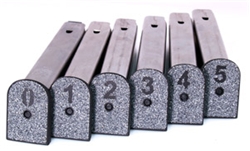 By George Emanuel
By George Emanuel
Let’s dive into a critical aspect of firearm ownership that’s often overlooked: magazines. There’s a saying that goes, “Two is one, and one is none.” If you haven’t heard it before, allow me to explain why it’s so relevant, especially in a self-defense scenario. If I begin with two, and one is lost or damaged, I now have one. But, had I started with one which became damaged or lost I would then have none.
The Achilles’ heel of semi-automatic pistols is their magazines. They can cause a range of malfunctions—misfeeds, failures to feed, double feeds, and more—essentially everything except perhaps failures to fire, extract, or eject.
So, how many magazines should you own? Let me share a personal story to illustrate the importance. Some years back, I bought a clone of a popular semi-automatic pistol from a reputable manufacturer. The dealer assured me that original magazines would work just fine with it, but when I finally got them, they didn’t fit. To make matters worse, the clone manufacturer had discontinued making the correct magazines, leaving me with only the two unreliable magazines that came with the gun.
Frustrated and feeling misled, I eventually traded in that pistol for the genuine article, taking a financial hit in the process. It was a tough lesson learned: having too few reliable magazines can leave you in a tough spot when you need your firearm the most.
So, how many magazines should you have? Ideally, more than you think you need. Even if you purchase ten magazines, there’s a possibility that one or more might not function reliably. Over time, all magazines will wear out through regular use, so it’s essential to plan accordingly.
One practical tip is to mark or number your magazines. Whether with a paint marker, nail polish, or specialized floor plates, this helps distinguish your reliable “everyday carry” (EDC) magazines from those used for practice. The ones that consistently feed rounds into the chamber without issues should be your EDC mags, while the others become your practice mags.
Now, you might wonder why bother practicing with magazines that are prone to malfunction. The truth is, all magazines will eventually fail, and practicing with them prepares you for the day you’ll need to clear a malfunction swiftly and effectively. This readiness is critical for your safety in a real-life self-defense situation.
If you typically carry one magazine in your gun and one as a spare, consider setting aside three magazines as your primary EDC and backup. Rotate these regularly during practice sessions to ensure they’re always reliable. Should one fail during practice, use your backup until you can replace the faulty one.
When practicing at the range, handle your practice magazines normally. Dropping them can cause damage that compromises their reliability. Numbering your magazines beforehand helps identify any that develop issues during practice, and allows you to select them specifically so that you can practice with the damaged magazines to keep you sharp and aware.
At least annualy or more often depending on usage, it’s crucial to clean and inspect your magazines thoroughly. DO NOT use oil inside the magazine as it attracts dirt and debris. Instead, use a dry cloth to wipe down the spring and follower, ensuring they’re free of any contaminants that could affect performance.
Investing in quality magazines and regularly testing them with your firearm and defensive ammunition is not just advisable—it’s essential. A firearm is a system, and every component must work together flawlessly when it counts. Don’t skimp on this crucial aspect of firearm preparedness.
If this seems like overkill to you, consider the consequences of being unprepared in a life-threatening situation. A gunfight is no place for “oops” or shortcuts. Your readiness can make all the difference in protecting yourself and your loved ones.
Thanks for taking the time to read this, and remember, stay safe and stay prepared.